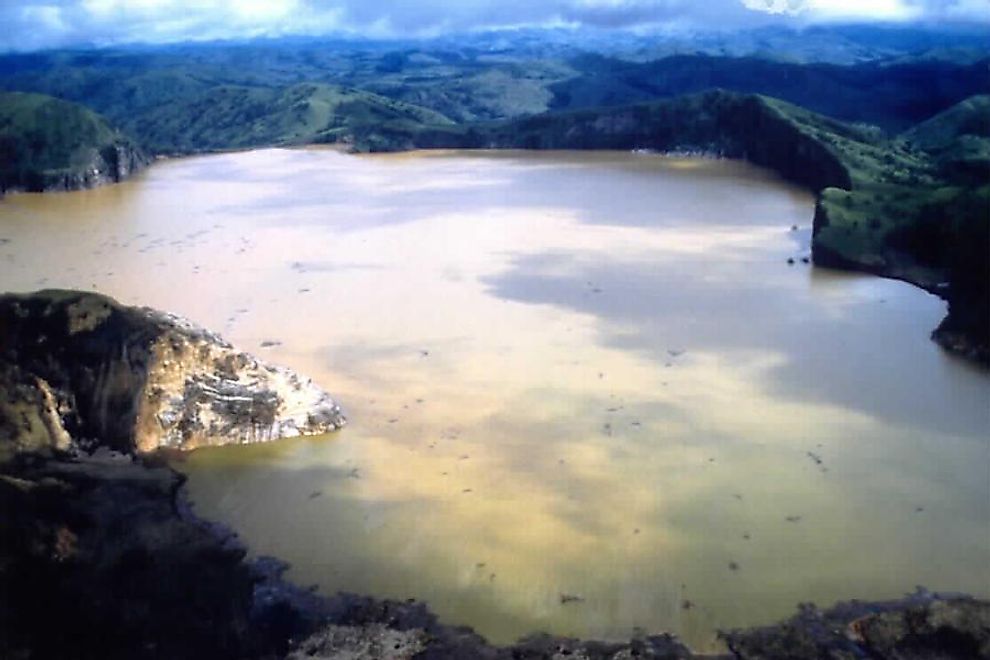The Deadliest Lake On The Planet

Where Is The Deadliest Lake In The World Located?
Lake Nyos, definitely the deadliest lake in the world, is located in Cameroon’s Northwest Region. It is a crater lake that lies along the Cameroon line of volcanic activity. Since the lake sits on a pocket of magma, the waters of the lake is highly acidic due to the carbon-dioxide (CO2) spewed into the waters from the magma layer below.
Geography Of Lake Nyos
Although Lake Nyos lies within an extinct volcano, magma still flows beneath it. The carbon-dioxide leaking through the earth from the magma layers first dissolve in the natural springs around the lake and then finally mix with the lake waters to produce carbonic acid. Nearly 90 million tons of CO2 is charged into the waters of the lake from the magma layer. A natural dam made of volcanic rocks holds the waters of the lake in place. The wall is 130 feet high and 148 feet wide.
Lake Nyos is a thermally stratified lake, meaning a layer of warm water of low-density floats on the denser, colder water layer near the bottom of the lake. Usually, the CO2 remains in solution in the colder layers below and the lake remains stable. On certain occasions, if the lake water becomes supersaturated with CO2 or when a landslide or earthquake happens in the region, the CO2 might suddenly come out of solution, triggering an explosion.
What Makes Lake Nyos The World’s Deadliest Lake?
On August 21, 1986, Lake Nyos experienced a limnic eruption. The eruption triggered the release of about 100,000–300,000 tons of CO2 . The gas cloud rose at an incredible speed of 100 km/hr and soon displaced all of the air in the surrounding regions. This killed 1,746 people and 3,500 livestock in the region by suffocation. The villages of Nyos, Suburn, and Cha were worst affected.
The outgassing turned the waters of the lake a deep red color due to the iron-rich water from below coming to the surface and getting oxidized. The level of the lake also fell by about a meter and trees in the region were knocked down. It is estimated that the eruption released about 1.2 cubic kilometres of gas. The incident is termed as the largest mass-scale asphyxiation caused due to natural causes.
What Triggered The Eruption?
Scientists are still debating the cause of the sudden eruption. Some claim that it was caused due to a landslide in the region. Others suspect a small volcanic eruption below the lake. The possibility of an earthquake triggering the disaster is also not completely ruled out.
How Dangerous Is The Lake Today?
The people and animals living around the Lake Nyos are still not safe. According to scientists, outgassing events might occur every 10 to 30 years. However, some suggest an even earlier accident since the rapidly eroding natural dam of the lake might lead to lowering of water pressure on the lake and thus a release of CO2.
What Can Be Done?
After the 1986 disaster was over, people once more started settling in the lake area. They stated reasons of soil fertility and their sentiments for ancestral lands as reasons to resettle in such a dangerous zone. Hence, the government of the region and other international agencies have attempted to render the lake safe for settlement.
Degassing columns have been installed from rafts in the lake. The columns work to pump CO2 saturated water from below the lake to the surface. This process leads to the release of pressure and thus CO2 from the water surface, preventing the build-up of CO2 over time.











